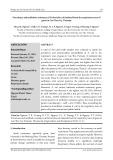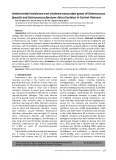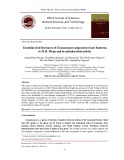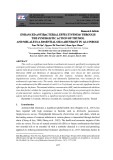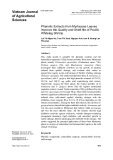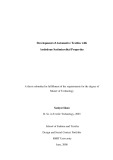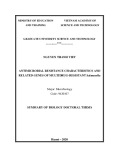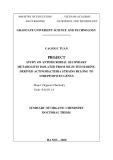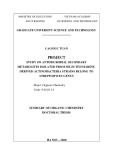M I N I R E V I E W
Recent applications of NMR spectroscopy in plant metabolomics Jane L. Ward, John M. Baker and Michael H. Beale
The National Centre for Plant and Microbial Metabolomics, Rothamsted Research, Harpenden, UK
Keywords fingerprinting; NMR; plant metabolomics; substantial equivalence
Correspondence M. Beale, The National Centre for Plant and Microbial Metabolomics, Rothamsted Research, West Common, Harpenden, AL5 2JQ, UK Tel: +44 1582 763133 E-mail: Mike.beale@bbsrc.ac.uk
(Received 19 October 2006, revised 15 November 2006, accepted 20 November 2006)
doi:10.1111/j.1742-4658.2007.05675.x
Recent research has established NMR as a key method for high-through- put comparative analysis of plant extracts. We discuss recent examples of the use of NMR to provide metabolomic data for various applications in plant science and look forward to the key role that NMR will play in data provision for plant systems biology.
Introduction
them to ionize. Metabolite screening requires maxi- mum sensitivity with a broad compound coverage. For NMR this usually means that only the most sensitive and commonly occurring magnetic nucleus (i.e. 1H) is observed. However, more information on topics such as metabolite flux can be obtained with other nuclei, particularly 13C and 15N. In this minireview we high- light progress in plant metabolomics where 1H-NMR has been used in substantial equivalence and functional genomics studies. In addition, the recent use and pros- pects for heteronuclear NMR, 2D NMR, liquid chro- matography (LC)-NMR and stable isotope labelling experiments are also described.
NMR fingerprinting
Abbreviations GM, genetic modification; HSQC, heteronuclear single quantum correlation; J-Res, 1H J-Resolved; PCA, principal component analysis; LC, liquid chromatography; PEG, polyethylene glycol; PLS-DA, prediction to latent structures-discriminant analysis; SPE, solid phase extraction; TCA, tricarboxylic acid.
FEBS Journal 274 (2007) 1126–1131 ª 2007 The Authors Journal compilation ª 2007 FEBS
1126
Fingerprinting techniques involve collecting spectra of unpurified solvent extracts in standardized conditions and ignore, initially, the problem of making individual Nuclear magnetic resonance (NMR) spectroscopy is usually the method of choice for natural product struc- ture determination and it is not surprising that this powerful technique has come to the fore in plant meta- bolomics. The data requirements for metabolomics are the qualitative and quantitative analyses of the maxi- mum number of metabolites in the highest achievable throughput. Most metabolomics laboratories deploy a range of spectroscopic technologies but use of NMR spectroscopy, particularly as a first pass screen, has a number of advantages over other analytical platforms currently being used. Sample preparation is relatively simple when compared to other analytical methods and a high sample throughput with little instrument drift is readily achieved. NMR is not discriminatory unlike certain mass spectrometry methods that rely on the prior derivatization of metabolites or the ability of
J. L. Ward et al.
NMR spectroscopy in plant metabolomics
(in proline,
trigonelline and significant differences other phenolics) between parents and GM lines with modified polyamine metabolism. Generally lines from the other GM groups had altered levels of other com- pounds relative to the controls, but the differences in mean values amounted only to a two- to three-fold change. It was suggested that, in the context of variab- ility of the whole dataset, such changes did not appear to be important.
assignments of peaks in the resulting complex NMR spectra, which contain many overlapping peaks. Multi- variate statistical methods such as principal component analysis (PCA) are used to compare sets of spectra to identify clusters of similarity or difference so that con- clusions can be drawn about the classification of indi- vidual plant samples. The identities of metabolites responsible for differences between classes can be investigated from loadings plots generated by PCA and related techniques. The technique has been recently reviewed by Krishnan et al. [1]. Here we dis- cuss recent applications of the technique in a number of key areas. importance. When dealing with plants,
Substantial equivalence
Multivariate methods, such as PCA and PLS-DA, build models from the datasets provided and when developing conclusions from these models, the context must be considered. The experimental design is of utmost the major differences revealed in principal component 1 (PC1) can sometimes be due to environmental effects. Use of different cultivars can also bias the model. The biological differences (e.g., between GM and non-GM) can be masked and will often only be revealed in the lower PCs. These differences may therefore need to be further studied in refined models where cultivar differ- ences and environmental effects are excluded [3].
Food authenticity and quality control
Regulatory bodies are placing much emphasis on the identification of unintended effects of genetic modifica- tion (GM) and there has recently been a drive to establish methods of analysis to screen for these. NMR fingerprinting with multivariate analysis of the data has been used to identify and classify maize seeds, obtained from transgenic plants, into different classes according to changes in metabolites [2]. Prediction to latent structures-discriminant analysis (PLS-DA) meth- ods were used to build a predictive model that could identify GM material by virtue of only 13 variables that were sufficient to explain 90% of the variability in the entire dataset.
NMR fingerprinting has been used for many years to authenticate foodstuffs, especially in the beverage industry. A recent study has employed the method to investigate grape quality [5]. The aim was to investi- gate the effect on grape berry skin metabolites of three cultivars grown over three seasons at five different geo- graphical locations. Using standard methods of NMR data collection, followed by PCA and PLS methods, the predictive modelling was able to pinpoint the spec- tral areas responsible for a separation according to vintage. No effects due to soil could be discerned and it was concluded that the vintage effect on grape meta- bolic profiles prevailed over any soil effect. Quality control
In a larger study the ‘substantial equivalence’ of three transgenic wheats, grown in the field at two dif- ferent sites for 3 years, has been examined using NMR fingerprinting [3]. Multivariate analysis of the data col- lected from extracts of flour, milled from the wheat seeds, showed that there was a stronger influence of site and year than there was due to genotype. Although one transgenic line showed elevated levels of carbohydrates, relative to its parent line, most changes detected (e.g., in free amino acids) were due to envi- ronment. It was concluded that the plant growth environment has a very significant effect on the meta- bolome, and that generally differences between control and transgenic wheat lines were within the range of those environmental differences.
issues are becoming increasingly important in the area of phytomedicinal preparations. A recent study on chamomile flowers, employing NMR and chemometrics addressed concerns about variation in composition [6]. The study demonstrated that NMR screening will play an important role in standardization and quality control as legislation is introduced into this area.
Functional genomics
FEBS Journal 274 (2007) 1126–1131 ª 2007 The Authors Journal compilation ª 2007 FEBS
1127
Similar NMR fingerprinting studies, assessing the compositional changes occurring in potato tubers after trangenesis, concluded that environmental and cultivar effect were on the whole greater than unintended effects of GM [4]. Approximately 40 GM lines modified in primary carbon metabolism, starch synthesis, glyco- protein processing and polyamine ⁄ ethylene metabolism were compared. The most obvious differences revealed by PCA, were between varieties. There were however, In functional genomics, high-throughput methods that are capable of screening large collections of plants are extremely useful. Metabolomics information can not only assist in a deeper understanding of the complex
J. L. Ward et al.
NMR spectroscopy in plant metabolomics
the this include
technique is
interactive nature of plant metabolic networks and their responses to genetic change but also will provide unique insights into the fundamental nature of plant phenotypes in relation to development, physiology and environment. Quantitative metabolite profiling by 1H NMR has recently been used for a genetic study of strawberry fruit quality, a functional study of tomato transformants and a study of Arabidopsis thaliana phosphoenolpyruvate transformants [7]. In the tomato study, a comparison of the roots of transformants with wildtypes showed that environmental factors signifi- cantly modified the metabolic status of the plants, masking the expression of a given genetic background. Studies on the Arabidopsis transformants showed that a decrease in phosphoenolpyruvate carboxylase activity impacted on metabolic profile without compromising the plant growth, supporting previous suggestions that the enzyme had a low influence on the carbon flux through the tricarboxylic acid (TCA) cycle.
Many laboratories are now collecting both meta- bolomics and transcriptomic datasets from the same tissues and are developing techniques for cross-correla- tion of these information-rich matrices. No one has yet published such studies with NMR, but a recent exam- ple, using GC-MS [8] where the analysis of transcri- ptome and metabolome datasets gathered in response to sulphur starvation has been modelled, indicates what may be done with such correlative datasets.
Two-dimensional NMR studies
Although 1D NMR studies are extremely useful in classifying similar groups of samples, problems with large numbers of overlapping peaks can make actual identification of large numbers of metabolites difficult. 2D NMR studies can help to overcome these prob- lems. The use of 2D NMR for metabolomics is usually restricted to the characterization of unidentified com- pounds from the 1D spectra. This can be carried out on the isolated compound (see below). Alternatively, the increased resolution provided by the second dimen- sion can allow for the characterization of components in an unfractionated or partially fractionated mixture. Examples of characterization of tomato juice [9] and the identification of the phenyl- jasmonate treated propenoids produced by methyl Brassica rapa [10] and A. thaliana [11]. The only 2D NMR method that is truly amenable for use as a metabolomic fingerprinting that of 1H J-Resolved (J-Res) NMR, due to its comparatively short acquisition time, relative to other 2D techniques. Figure 1A depicts the complex central region of the 1H-spectrum of a polar extract of conventional A. thaliana. The ‘skyline projection’ [12] (Fig. 1B) gen- erated from the 2D J-Res spectrum (Fig. 1C), is effect- ively a proton decoupled 1H spectrum. In the projection, multiplets revealed in the 2D J-Resolved plot, are coalesced into single peaks of increased inten- sity at the chemical shift positions of the multiplet cen- tres. As can be seen in Fig. 1 the result is a spectrum, retaining all the chemical shift and relative intensity data, but with a reduced degree of complexity com- pared to the conventional 1H spectrum. Choi et al. [13] used this technique to investigate the response of tobacco to infection with the mosaic virus. They were able to detect increases in a range of compounds,
A
B
4.05
4.00
3.95
3.90
3.85
3.80
3.75
3.70
3.65
3.60
3.55
3.50
3.45
p.p.m.
Hz
C
-10
0
10
20
Fig. 1. Carbohydrate region from 1H NMR spectra of an Arabidopsis thaliana D2O-CD3OD (8 : 2) extract. The conventional 1D spectrum (A); the skyline projection from 2D-J-Res spectroscopy (B); the 2D J-Res spectrum (C). The skyline projection is gen- erated from the 2D plot. A representative triplet at 4.035 p.p.m. (from sucrose) is highlighted and demonstrates the coales- cence of a multiplet in the conventional spectrum to yield a single line with a summed area in the skyline projection, whilst singlets (e.g., 3.904 p.p.m.) remain unchanged.
FEBS Journal 274 (2007) 1126–1131 ª 2007 The Authors Journal compilation ª 2007 FEBS
1128
J. L. Ward et al.
NMR spectroscopy in plant metabolomics
including 5-caffeoylquinic acid, a-linolenic acid ana- logues, sesquiterpenoids and diterpenoids, and have suggested that these may have a role in systemic acquired resistance.
Metabolite profiling using LC-NMR
such as plant
Even with the added resolution of 2D NMR tech- niques, the complete characterization of complex mix- tures extracts by NMR is often impossible. Hyphenating NMR to HPLC alleviates some of the problem by allowing NMR data to be col- lected on individual components of a mixture. Such on-flow NMR has been used as a means of screening the HPLC profiles of crude lipophilic extracts of aqua- tic plants for potential algacides [14,15]. The com- pounds of interest could not be completely identified from the LC-NMR analysis. However, it did give good clues as to the chemical nature of the constituents of the extract, thereby allowing targeted isolation of the most interesting compounds (labdane diterpenes) to be carried out.
describe an investigation of carbon flow into starch biosynthesis from added in maize kernals. Label [U-13C6]glucose and [U-13C12]sucrose was tracked by 13C NMR measurements on glucose isolated from de novo biosynthesized starch, after hydrolysis. 13C tra- cer studies, using [1,2-13C2]acetate, have also been employed to study the TCA cycle and interacting path- ways, in an in vivo and in vitro metabolomic analysis of rice coleoptiles during anaerbiosis [22]. Peak heights of selected, resolved, 13C NMR signals were normal- ized against those at time zero and plotted against treatment time to determine the in vivo time courses of labelled malate, glutamine, glutamate and c-amino- butyrate. The study showed that the TCA cycle under- went multiple cycles supporting a separate pool of glutamate, which after decarboxylation yielded c-amino- butyrate. Diverted carbon was replenished via the gly- oxylate cycle reactions. The rice coleoptiles had the ability to reduce the build up of glycolitic by-products (e.g., NADH) by consuming them in various reactions leading to the production of ethanol and amino acids. 13C analysis has also been supplemented by 31P NMR in metabolite profiling studies of perchloric acid extracts of cucumber radicles to reveal changes in phospholipid metabolism in response to osmotic stress and drought tolerance [23]. The radicles were rendered tolerant to desiccation by the addition of polyethylene glycol (PEG). NMR profiling showed increases in sucrose and large decreases in glucose, fructose and the hexose phosphate pool in response to PEG treat- ment. In addition, three derivatives arising early during phospholipids catabolism appeared in the PEG treated radicles and the study concluded that the metabolic response leading to the re-establishment of drought tolerance was different to that of an osmotic response.
The routine use of on-flow LC-NMR for phyto- chemical analysis is limited by its lack of sensitivity (the previous examples used HPLC runs of > 12 h). The advent of automated solid phase extraction (SPE) peak trapping [16] has removed this problem and allowed LC-NMR to achieve its full potential. The technique has been used to good effect to investigate the composition of an African medicinal plant Kanahia ianiflora [17]. Alcoholic extracts of the plant were investigated by analytical scale LC-SPE-NMR using multiple peak trapping, to give sufficient of each of the major peaks to allow their complete characterization using 1D and 2D NMR techniques. Four flavanol- glycosides and three 5a-cardenolides were successfully identified. Applications using 15N-labelling
Flux analysis by stable isotope tracking
The ability to monitor flux through individual metabo- lites over time has the potential to offer more to the systems biologist than the single snapshot NMR finger- printing that is widely used. There have, however, been a growing number of applications in recent years using 31P and stable isotopes such as 13C and 15N to investi- gate plant metabolism over time and the area has been extensively reviewed [18–20].
Applications using 13C-labelling
FEBS Journal 274 (2007) 1126–1131 ª 2007 The Authors Journal compilation ª 2007 FEBS
1129
Two recent studies serve to illustrate the application of 13C-NMR in flux analysis. Glawischnig et al. [21] In vivo 15N and 31P NMR studies have also been used to explore symbiotic nitrogen fixation in pea root nod- ules [25]. The study involved exposing detached pea nodules to 15N2 via a perfusion medium, while record- ing spectra over a time course. After these initial flux measurements, amino acids were extracted and identi- fied by 15N NMR analysis. These studies were comple- mented using LC-MS. In vivo 31P NMR spectroscopy was used to monitor the physiological state of the meta- bolically active nodules. The investigation also showed (via an unusual 15N chemical shift) that a substantial pool of free ammonium ion was present in active sym- biosis. Similar 15N and 31P studies have been employed to investigate primary metabolism in N2-fixing Alnus incana-Frankia symbiotic root nodules [25].
J. L. Ward et al.
NMR spectroscopy in plant metabolomics
Miccheli A et al. (2004) NMR-based metabonomic study of transgenic maize. Phytochemistry 65, 3187– 3198.
3 Baker JM, Hawkins ND, Ward JL, Lovegrove A,
Napier JA, Shewry PR & Beale MH (2006) A metabo- lomic study of substantial equivalence of field-grown genetically modified wheat. Plant Biotechn J 4, 381–392.
4 Defernez M, Gunning YM, Parr AJ, Shepherd LVT,
Davies HV & Colquhoun IJ (2004) NMR and HPLC- UV profiling of potatoes with genetic modifications to metabolic pathways. J Agric Food Chem 52, 6075–6085. 5 Pereira GE, Gaudillere JP, van Leeuwen C, Hilbert G, Maucourt M, Deborde C, Moing A & Rolin D (2006) H-1 NMR metabolite fingerprints of grape berry: Com- parison of vintage and soil effects in Bordeaux grape- vine growing areas. Anal Chim Acta 563, 346–352. 6 Wang YL, Tang HR, Nicholson JK, Hylands PJ,
Sampson J, Whitcombe I, Stewart CG, Caiger S, Oru I & Holmes E (2004) Metabolomic strategy for the classi- fication and quality control of phytomedicine: a case study of chamomile flower (Matricaria recutita L.). Planta Med 70, 250–255.
7 Moing A, Maucourt M, Renaud C, Gaudillere M,
Heteronuclear 13C-15N 2D NMR
The above studies have used stable isotope-feeding studies to answer specific biological problems using a targeted approach. A recent paper demonstrating the utility of stable isotope labelling and 2D heteronuclear NMR for a true metabolomics approach has recently been published [26]. The investigation centred on the metabolic movement of carbon and nitrogen in A. thaliana. Ethanol-stress responses were investigated by comparing 13C-labelled wildtype and 13C-labelled ethanol-hypersensitive mutant plants. In a separate study, nitrogen fluxes in 15N-labelled seeds have been analysed during the initiation of germination. Both studies relied on 2D heteronuclear techniques. 13C measurements were made by standard 1H-13C hetero- nuclear single quantum correlation (HSQC) procedures and the comparisons made by utilizing a spectral sub- traction routine. The same principles were applied to the analysis of the 15N nuclei where the authors repor- ted the first 1H-15N HSQC-type NMR experiment to track changes in N-containing metabolites during the onset of germination.
Concluding remarks
Brougisse R, Leboutellier B, Gousset-Dupont A, Vidal J, Granot D, Denoves-Rothan B et al. (2004) Quantita- tive metabolic profiling by 1-dimensional H-1-NMR analyses: application to plant genetics and functional genomics. Func Plant Biol 31, 889–902.
8 Nikiforova VJ, Gakiere B, Kempa S, Adamik M,
is clear that
Willmitzer L, Hesse H & Hoefgen R (2004) Towards dissecting nutrient metabolism in plants: a systems biology case study on sulphur metabolism. J Exp Bot 55, 1861–1870.
9 Sobolev A, Segre A & Lamanna R (2003) Proton high- field NMR study of tomato juice. Magn Reson Chem 41, 237–245.
10 Liang YS, Kim HK, Lefeber AWM, Erklens C, Lefeber AWM, Choi YH & Verpoorte R (2006) Metabolic dif- ferentiation of Arabidopsis treated with methyl jasmo- nate using nuclear magnetic resonance spectroscopy. Plant Sci 170, 1118–1124.
11 Hnedrawati O, Yao Q, Kim HK, Linhorst HJM,
Erklens C, Choi YH & Verpoorte R (2006) Identifica- tion of phenylpropenoids in methyl jasmonate treated Brassica rapa leaves using two-dimensional nuclear mag- netic resonance spectroscopy. J Chrom A 1112, 148–155.
for
12 Viant M (2003) Improved methods for the acquisition
and interpretation of NMR metabolomic data. Biochem Biophys Res Comm 310, 943–948.
NMR has a key role to play in the acquisition of qual- ity assured metabolomic datasets for the systems biolo- the now standard 1H-NMR gist. It fingerprinting will continue to be the main provider of and environmental large datasets functional genomics, and in substantial studies. equivalence Hyphenated and 2D techniques play a key role in compound identification and this will lead to more annotation of the 1D fingerprints, as well as answering specific questions by comparative analysis of individual mutants, transgenics or treatments. Systems biology researchers will require metabolomics data that pro- vides information on how plants change over time, whether that be by developmental programming, envi- ronmental perturbations or after attack by predators. There is no doubt that NMR fingerprinting and in particular metabolite flux analysis by NMR are now developing to an extent where they will become leading providers of such data.
References
13 Choi YH, Kim HK, Linhorst HJM, Hollander JG,
1 Krishnan P, Kruger NJ & Ratcliffe RG (2005) Metabo- lite fingerprinting and profling in plants using NMR. J Exp Bot 56, 255–265.
Lefeber AWM, Erklens C, Nuzillard JM & Verpoorte R (2006) NMR metabolomics to revisit the tobacco mosaic virus infection in Nicotiana tabacum leaves. J Nat Prod 69, 742–748.
2 Manetti C, Bianchetti C, Bizzarri M, Casciani L, Castro C, Ascenzo GD, Delni M, Di Cocco ME, Lagana A,
FEBS Journal 274 (2007) 1126–1131 ª 2007 The Authors Journal compilation ª 2007 FEBS
1130
J. L. Ward et al.
NMR spectroscopy in plant metabolomics
14 Waridel P, Wolfender JL, Lachavanne JB &
Hostettmann K (2003) ent-Labdene diterpenes from the aquatic plant Potamogeton pectinatus. Phytochemistry 64, 1309–1317.
15 Waridel P, Wolfender JL, Lachavanne JB &
21 Glawischnig E, Gierl A, Tomas A, Bacher A & Eisen- reich W (2002) Starch biosynthesis and intermediary metabolism in maize kernals. Quantitative analysis of metabolite flux by Nuclear Magnetic Resonance. Plant Physiol 130, 1717–1727.
Hostettmann K (2004) Ent-Labdene glycosides from the aquatic plant Potamogeton lucens and analytical evalua- tion of the lipophilic extract constituents of various Potamageton species. Phytochemistry 65, 945–954.
22 Fan TWM, Lane AN & Higashi RM (2003) In vivo and in vitro metabolomic analysis of rice coleoptiles revealed unexpected pathways. Russ J Plant Physiol 50, 787–793.
16 Exarchou V, Godejohann M, van Beek TA,
23 Avelange-Macherel M-H, Ly-Vu B, Delaunay J,
Gerothanassis IP & Vervoort J (2003) LC-UV-solid phase extraction-NMR-MS combined with a cryogenic flow probe and its application to the identification of compounds present in Greek oregano. Anal Chem 75, 6288–6294.
17 Clarkson C, Staerk D, Hansen SH & Jaroszewski JW
Richomme P & Leprince O (2006) NMR metabolite profiling analysis reveals changes in phospholipid metabolism associated with the re-establishment of desiccation tolerance upon osmotic stress in germi- nated radicles of cucumber. Plant Cell Environ 29, 471–482.
24 Scharff AM, Egsgaard H, Hansen PE & Rosendahl L
(2005) Hyphenation of solid-phase extraction with liquid chromatography and nuclear magnetic resonance: appli- cation of HPLC-DAD-SPE-NMR to identification of constituents of Kanahia laniflora. Anal Chem 77, 3547– 3553.
(2003) Exploring symbiotic nitrogen fixation in pea root nodules by in vivo 15N Nuclear Magnetic Resonance spectroscopy and liquid chromatography-mass spectro- metry. Plant Physiol 131, 367–378.
18 Ratcliffe RG, Roscher A & Schachar-Hill Y (2001) Plant NMR spectroscopy. Prog Nucl Magn Reson Spectrosc 39, 267–300.
25 Lundberg P & Lundquist P-O (2004) Primary meta- bolism in N2-fixing Alnus incana-Frankia symbiotic root nodules studied with 15N and 31P nuclear magnetic resonance spectroscopy. Planta 219, 661– 672.
26 Kikuchi J, Shinozaki K & Hirayama T (2004) Stable
19 Ratcliffe RG & Shachar-Hill Y (2001) Probing plant metabolism with NMR. Annu Rev Physiol Plant Mol Biol 52, 499–526.
isotope labelling of Arabidopsis thaliana for an NMR- based metabolomics approach. Plant Cell Physiol 45, 1099–1104.
20 Ratcliffe RG & Shachar-Hill Y (2005) Revealing meta- bolic phenotypes in plants: inputs from NMR analysis. Biol Rev 80, 27–43.
FEBS Journal 274 (2007) 1126–1131 ª 2007 The Authors Journal compilation ª 2007 FEBS
1131








